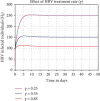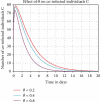Analysis of HBV and COVID-19 Coinfection Model with Intervention Strategies
- PMID: 37811291
- PMCID: PMC10558273
- DOI: 10.1155/2023/6908757
Analysis of HBV and COVID-19 Coinfection Model with Intervention Strategies
Abstract
Coinfection of hepatitis B virus (HBV) and COVID-19 is a common public health problem throughout some nations in the world. In this study, a mathematical model for hepatitis B virus (HBV) and COVID-19 coinfection is constructed to investigate the effect of protection and treatment mechanisms on its spread in the community. Necessary conditions of the proposed model nonnegativity and boundedness of solutions are analyzed. We calculated the model reproduction numbers and carried out the local stabilities of disease-free equilibrium points whenever the associated reproduction number is less than unity. Using the well-known Castillo-Chavez criteria, the disease-free equilibrium points are shown to be globally asymptotically stable whenever the associated reproduction number is less than unity. Sensitivity analysis proved that the most influential parameters are transmission rates. Moreover, we carried out numerical simulation and shown results: some parameters have high spreading effect on the disease transmission, single infections have great impact on the coinfection transmission, and using protections and treatments simultaneously is the most effective strategy to minimize and also to eradicate the HBV and COVID-19 coinfection spreading in the community. It is concluded that to control the transmission of both diseases in a population, efforts must be geared towards preventing incident infection with either or both diseases.
Copyright © 2023 Shewafera Wondimagegnhu Teklu.
Conflict of interest statement
The authors declare that they have no conflicts of interest
Figures














References
-
- Martcheva M. An Introduction to Mathematical Epidemiology . Vol. 61. New York: Springer; 2015. - DOI
-
- Khatun Z., Islam M. S., Ghosh U. Mathematical modeling of hepatitis B virus infection incorporating immune responses. Sensors International . 2020;1, article 100017 doi: 10.1016/j.sintl.2020.100017. - DOI
MeSH terms
LinkOut - more resources
Full Text Sources
Medical

